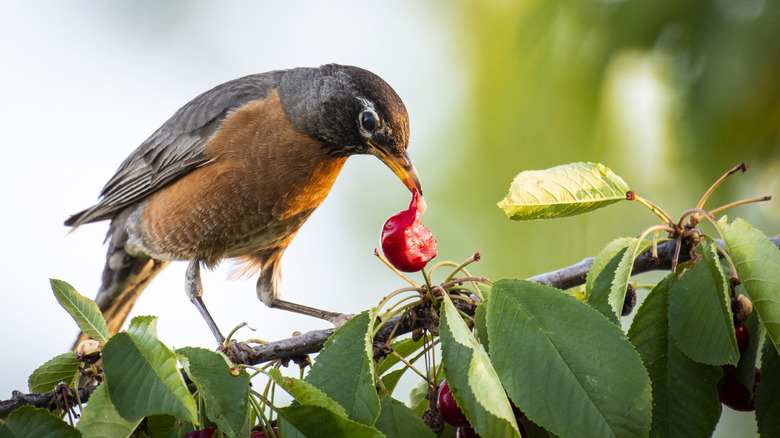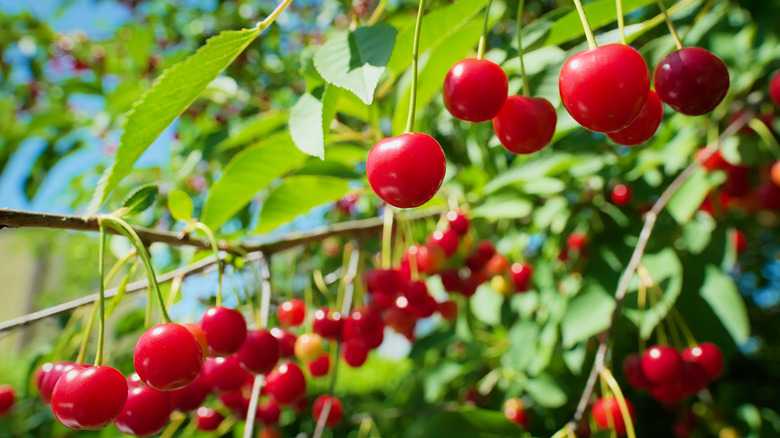The Fast-Producing Fruit Tree That Both Gardeners And Birds Can Enjoy
We may receive a commission on purchases made from links.
Seeking a fast-growing fruit tree for your yard? If you love birds and baking, consider a tart cherry tree (Prunus cerasus). Likely growing 1 to 2 feet per year, it can start producing fruit in 2 to 3 years, sometimes sooner, though a full crop may take a little longer. Also known as a sour cherry, this compact tree brims with white springtime blossoms before growing bright-red fruits, which ripen in the summer. These tart treats are ideal for jams, pie fillings, and baked goods such as scones and strudels. The 'Montmorency' variety is often made into juice that's touted for its anti-inflammatory properties. Birds also flock to tart cherries, which provide them with vitamin C and other nutrients. According to researchers from Michigan State University, robins and grackles are particularly fond of this fruit. Other cherry fans include bluebirds, cardinals, mockingbirds, orioles, and waxwings.
If you're planning to grow tart cherries for your own use, devise a bird strategy. Otherwise, these voracious eaters may consume most of your harvest. To protect your cherries from beaks, try placing a sprinkler with a motion sensor nearby or a noise-making decoration, such as Mfeesob large aluminum wind chimes. That said, you should also consider sharing some of your bounty with the birds. When you make cherries accessible to wildlife, you will likely see a wider range of feathered friends in your yard. Also, watch for butterflies, which help nearby fruit and vegetable plants reproduce. Tart cherry trees are an important habitat for Eastern tiger swallowtail larvae. The youngest caterpillars are brown and white, the older ones are green, and mature butterflies have yellow and black markings.
Tart cherry varieties to consider
When selecting a tart cherry, consider the size, sun exposure, and weather patterns of your growing site. Tart cherries like full sun and tolerate many kinds of soil as long as drainage isn't an issue. Morello cherries, however, can thrive in shady yards. Cultivars in this group include 'Balaton' and 'Danube.' In general, tart cherries perform well in USDA hardiness zones 3a through 8b. Do not grow them in Virginia or eastern Maryland, where they are considered invasive. Though they are fine to grow elsewhere in the U.S., some cultivars will fare better than others in the region you call home.
Your region's winter temperatures are important to take into account when shopping for a tart cherry. Many tart cherries need to spend 1,000 hours at 35 to 55 degrees Fahrenheit before the growing season begins. Verify when frost danger ends where you live and when the tree you're considering is likely to bloom. Developing fruit may be damaged when frost harms your tree's flowers. If end-of-spring frost is a concern, consider the late-blooming 'Surefire' cultivar.
If you're working with limited space, you can plant just one tart cherry since most varieties are self-pollinating. Dwarf trees, which grow 5 to 12 feet tall, are easiest to harvest since most of their branches are within reach. Plus, they tend to offer a harvest sooner than standard-size tart cherry trees. Many cultivars are available in this size, including large-fruited, container-friendly 'Wowza!' and disease-resistant 'North Star.' To encourage fruit production, prune your cherry tree at the right time of year, typically early spring, and give it a nitrogen boost around the same time.

